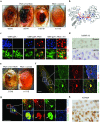Drosophila screen connects nuclear transport genes to DPR pathology in c9ALS/FTD
- PMID: 26869068
- PMCID: PMC4751451
- DOI: 10.1038/srep20877
Drosophila screen connects nuclear transport genes to DPR pathology in c9ALS/FTD
Abstract
Hexanucleotide repeat expansions in C9orf72 are the most common cause of amyotrophic lateral sclerosis (ALS) and frontotemporal degeneration (FTD) (c9ALS/FTD). Unconventional translation of these repeats produces dipeptide repeat proteins (DPRs) that may cause neurodegeneration. We performed a modifier screen in Drosophila and discovered a critical role for importins and exportins, Ran-GTP cycle regulators, nuclear pore components, and arginine methylases in mediating DPR toxicity. These findings provide evidence for an important role for nucleocytoplasmic transport in the pathogenic mechanism of c9ALS/FTD.
Figures


References
-
- Mori K. et al.. The C9orf72 GGGGCC repeat is translated into aggregating dipeptide-repeat proteins in FTLD/ALS. Science 339, 1335–1338 (2013). - PubMed
Publication types
MeSH terms
Substances
Grants and funding
LinkOut - more resources
Full Text Sources
Other Literature Sources
Medical
Molecular Biology Databases
Miscellaneous

